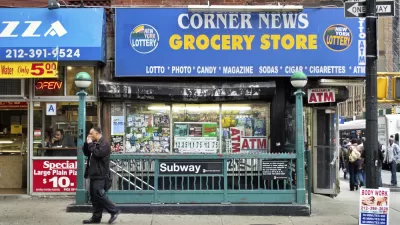An estimated 500,000 residents of the Atlanta area live without access to grocery stores. A recent article asks the obvious question: “Why can we build multimillion-dollar highway systems and multibillion-dollar stadiums but not more grocery stores?"
“Indeed, more than half a million people in the city of Atlanta and the ten counties that surround it live in neighborhoods the U.S. Department of Agriculture classifies as food deserts,” writes Rebecca Burns in a thoughtful and broad examination of the food desert problem in Atlanta and its surrounding suburbs.
Perhaps surprisingly, food deserts expand well into the suburban surroundings of Atlanta: “You don’t find these nutritional wastelands only in places like Bankhead; it’s even harder to get fresh, healthy food in the suburbs. In Cobb County, 75,000 people are food desert residents, as are 124,000 in Clayton.”
Moreover, “Getting fresh food isn’t only a problem for the poorest Atlantans. Areas most of us would hardly consider underprivileged—the middle-class suburbs of DeKalb County or the gentrified enclaves around Grant Park, for instance—are labeled 'low access' by the USDA, meaning at least a third of the people who live there have to travel a mile or more to get to a grocery store.”
FULL STORY: Stranded in Atlanta's Food Deserts

Alabama: Trump Terminates Settlements for Black Communities Harmed By Raw Sewage
Trump deemed the landmark civil rights agreement “illegal DEI and environmental justice policy.”

Planetizen Federal Action Tracker
A weekly monitor of how Trump’s orders and actions are impacting planners and planning in America.

The 120 Year Old Tiny Home Villages That Sheltered San Francisco’s Earthquake Refugees
More than a century ago, San Francisco mobilized to house thousands of residents displaced by the 1906 earthquake. Could their strategy offer a model for the present?

Ken Jennings Launches Transit Web Series
The Jeopardy champ wants you to ride public transit.

BLM To Rescind Public Lands Rule
The change will downgrade conservation, once again putting federal land at risk for mining and other extractive uses.

Indy Neighborhood Group Builds Temporary Multi-Use Path
Community members, aided in part by funding from the city, repurposed a vehicle lane to create a protected bike and pedestrian path for the summer season.
Urban Design for Planners 1: Software Tools
This six-course series explores essential urban design concepts using open source software and equips planners with the tools they need to participate fully in the urban design process.
Planning for Universal Design
Learn the tools for implementing Universal Design in planning regulations.
Clanton & Associates, Inc.
Jessamine County Fiscal Court
Institute for Housing and Urban Development Studies (IHS)
City of Grandview
Harvard GSD Executive Education
Toledo-Lucas County Plan Commissions
Salt Lake City
NYU Wagner Graduate School of Public Service





























